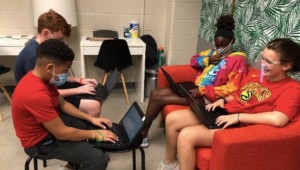10 Strategies for Strengthening Academic and Social Support

By Tom Vander Ark and Mary Ryerse
The College Readiness Initiative is a statewide secondary school grant program launched by College Spark Washington in 2006 where schools implement a personalized guidance system and/or the AVID program.
A longitudinal evaluation of the program showed promising and informative results: course taking patterns and achievement improved, and high school graduation and college enrollment rates improved. Evaluation of these 39 grantee schools and other AVID deployments suggests 10 lessons for improved readiness.
1. Teach skills for academic success, including organization, time management. In their research-based book Thriving in College and Beyond, authors According to Cuseo, Fecas and Thompson indicate that college students “who have difficulty managing their time have difficulty managing college” and point to the importance of developing these skills while in high school. Management of time and energy and learning to set priorities can make the difference between success and failure for new college students.
2. Embed tutorials in the learning process. Relationships and processes developed through tutoring can power academic success. AVID tutorials rely on small group processes and tap into local college students and online resources, making it affordable at scale.
3. Build strong student-teacher relationships. AVID CEO Sandy Husk said that leading districts in three states taught her about the primacy of student-teacher relationships.
Gallup’s The Engagement Gap report indicates that excellent teachers, supported by school leaders, keep students engaged in the learning process and hopeful about their own future. In fact, students who strongly agreed that their school is committed to building students’ strengths and that they have a teacher who makes them excited about the future are almost 30 times as likely to be engaged learners as their peers who strongly disagreed with both statements.
4. Create positive peer group for students. Increasing social awareness and peer-to-peer bonds is an important part of the AVID elective class, where students identify with a positive peer group (and even own it with t-shirts or other identifiers as other school clubs and co-curriculars do). As outlined in a CDC Report on school connectedness, students’ health and educational outcomes are influenced by the characteristics of their peers, such as how socially competent peer group members are or whether the peer group supports pro-social behavior (e.g., engaging in school activities, completing homework assignments, helping others).
5. Develop academic mindset and culture. Personal achievement gained through hard work and determination. In an interview with Harvard Business Review, mindset-guru Carol Dweck sums up a growth mindset: “In a growth mindset, challenges are exciting rather than threatening. So rather than thinking, oh, I’m going to reveal my weaknesses, you say, wow, here’s a chance to grow.”
6. Expect college eligible for all students. Sandy Husk said it’s not good enough to offer access to a college preparatory curriculum, system much demand equitable access for all students. AVID offers middle school courses to build academic language, leadership skills, and overall sense of commitment to school and college readiness goals. These courses prepare students for the rigors of a college preparatory curriculum in high school.
7. Encourage stretch courses and provide real-time support. Community college research suggests that students stretching to take for-credit “corequisite courses” with academic support rather than developmental courses were more likely to be successful in college. ASU has 25 years of positive experience with stretch courses.
AVID’s schoolwide program encourages stretch course taking including a partnership with International Baccalaureate.
8. Support dual enrollment. Many states, districts and networks have better-aligned graduation requirements with college eligibility requirements and are improving access to dual enrollment opportunities. Students benefiting from the College Readiness Initiative doubled their pursuit of dual credits.
9. Promote college aspirations. AVID schools create college-going aspirations by making students aware of the value of college, by supporting college visits, providing dual enrollment options (#7).
10. Focus on college completion. A decade ago, leading school networks observed that even though they were sending nearly all of their students to college, completion rates were disappointingly low. In addition to focusing on deeper learning and building persistence skills, AVID and leading networks are increasing efforts to improve the college match process and provide support while in college (AVID Student Success Initiative, Aspire Public School’s College for Certain and Achievement First Alumni Support, and KIPP Through College).
In addition to serving 1.5 million students in almost 6,000 secondary schools and institutions of Higher education, AVID is helping to create college readiness proof points and best practice lessons like these 10 strategies for strengthening academic and social supports.
This blog is part of a content series produced in partnership with College Spark Washington (@CollegeSparkWA). Join the conversation on Twitter using #CollegeReady or #RedefiningReady. To learn more about Integrating Readiness:
| Theme | College, Career & Life Readiness | Academic and Social Supports |
| White Paper | An Integrated Approach to College, Career & Life Readiness: A Case Study on Personalizing Guidance | An Integrated Approach to Academic & Social Supports: A Case Study on Increasing Access through AVIDTo be released May 2017 |
| Infographic | Every Student Deserves a Champion | Academic and Social Supports Drive Student SuccessTo be released May 2017 |
| Featured Program |
CGW (@waOSPI) personalizes guidance and provides a student-centered approach to college, career and life readiness by helping students understand who they are, where they’re headed and how they’ll get there.
|
The AVID (@AVID4College) program provides strong academic and social supports that prepare students for college and create a school-wide culture of college readiness.
|
For more, see:
- How to Promote College Readiness: A Washington State Case Study
- A Personalized and Integrated Approach to College, Career and Life Readiness
- 11 Essentials For Maximum Impact on Student College Prep Success
- The Three Keys to College Persistence
- Smart List: 50 Organizations Boosting College Access & Success
Stay in-the-know with all things EdTech and innovations in learning by signing up to receive the weekly Smart Update. This post includes mentions of a Getting Smart partner. For a full list of partners, affiliate organizations and all other disclosures please see our Partner page.










0 Comments
Leave a Comment
Your email address will not be published. All fields are required.